 W
WThe United States Coast Guard Aids To Navigation Team, ANT Coos Bay was established in 1976 and is located near the mouth of Coos Bay in the fishing and tourist community of Charleston, Oregon, southwest of the city of Coos Bay. ANT Coos Bay's area of responsibility ranges over 240 miles of the Oregon coast and includes 3 lighthouses, 18 primary buoys, 43 secondary buoys and 156 other lights, day beacons and fog signals.
 W
WThe Bay-class tugboat is a class of 140-foot (43 m) icebreaking tugboats of the United States Coast Guard, with hull numbers WTGB-101 through to WTGB-109.
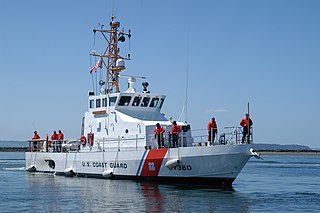 W
WUSCGC Blue Shark (WPB-87360) is an 87-foot (27 m) long Marine Protector-class coastal patrol boat of the United States Coast Guard built by Bollinger Shipyards in Lockport, Louisiana.
 W
WCharleston is an unincorporated community in Coos County, Oregon, United States. Charleston is the least populated community in Oregon's Bay Area and is Home to a large commercial fishing fleet, it is adjacent to the ocean entrance to Coos Bay. Charleston is the site of the Oregon Institute of Marine Biology and the United States Coast Guard Charleston Lifeboat Station.
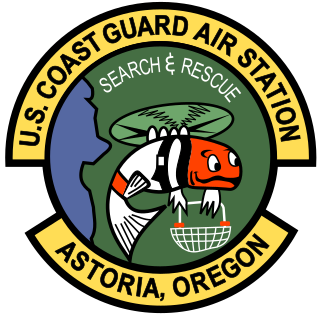 W
WCoast Guard Air Station Astoria was established August 14, 1964 at Astoria Regional Airport in Warrenton, Oregon.
 W
WCoast Guard Air Station North Bend was established September 28, 1974 at Southwest Oregon Regional Airport in North Bend, Oregon, United States. The unit houses 153 active duty, nine reserve duty and five civilian personnel. The unit operates five Eurocopter HH-65 Dolphin helicopters. CGAS North Bend received its first upgraded HH-65C Dolphin in 2007 The unit functions include search and rescue, law enforcement, marine environmental protection, aids to navigation, and enforcement of federal treaties.
 W
WUnited States Coast Guard Base Boston is located in the North End, Boston, Massachusetts. It is home to a number of cutters, including the USCGC Escanaba (WMEC-907), USCGC Spencer (WMEC-905), USCGC Flying Fish, USCGC Pendant, and USCGC Seneca (WMEC-906), along with other small fleet units. The small boat station located on the base was re-opened in 2003 after being closed in 1996. It is also home to Flotilla 5-3 of the United States Coast Guard Auxiliary.
 W
WThe Coast Guard Honor Guard Badge is a qualification badge of the United States Coast Guard which recognizes those personnel who are/have been permanently assigned to the Ceremonial Honor Guard Unit at the U.S. Coast Guard Telecommunications and Information Systems Command (TISCOM), Alexandria, Virginia. The badge was inspired by the Tomb of the Unknown Soldier Guard Identification Badge.
 W
WThe Coast Guard Officers' Sword, used by the United States Coast Guard, is almost identical to the Model 1852 Naval Officers Sword. The only difference is that the Coast Guard Officers' Sword has US Coast Guard inscribed on it instead of US Navy. It is of similar style as officer's sword used by the United States Revenue Cutter Service, the predecessor of the Coast Guard.
 W
WCoast Guard One is the call sign of any United States Coast Guard aircraft carrying the President of the United States. Similarly, any Coast Guard aircraft carrying the Vice President is designated Coast Guard Two.
 W
WUnited States Coast Guard Station Brant Point is located on Brant Point, in Nantucket, Massachusetts.
 W
WCoast Guard Station Burlington, Vermont is a United States Coast Guard station established in 1948 as a four-man light attendant station on Juniper Island. Currently the Station is located on the waterfront of Burlington, Vermont, in a facility built in 1993. Some of the missions they conduct are Maritime Law enforcement, Search and Rescue, Ice Rescue, and Aids to Navigation (ATON). They currently operate one 25-foot Defender-Class Boat, one Trailerable Aids Navigation Boat and one 49-foot Buoy Utility Stern Loading
 W
WUnited States Coast Guard Station Chatham is a United States Coast Guard station located in Chatham, Massachusetts. The station was the origin of the famous 1952 Pendleton rescue.
 W
WUnited States Coast Guard Station Gloucester is a United States Coast Guard station located in Gloucester, Massachusetts. It is located on Harbor Loop on the Mainland. The first successful US Coast Guard Air Station was CGAS Ten Pound Island in Gloucester Harbor, which operated from 1925 to 1935.
 W
WU.S. Coast Guard Station Golden Gate is a U.S. Coast Guard station in Sausalito, California. It falls under Coast Guard Sector San Francisco in the U.S.C.G.'s District Eleven.
 W
WUnited States Coast Guard Station Merrimack River is a United States Coast Guard station located in Newburyport, Massachusetts. It is one of the 20 surf stations in the Coast Guard. Its primary missions include search and rescue and law enforcement.
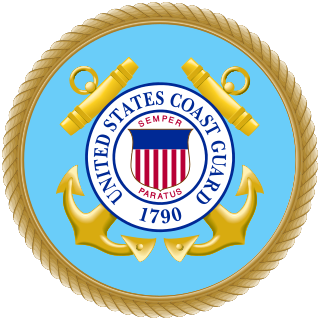 W
WUnited States Coast Guard Station New Haven is located at 120 Woodward Avenue, New Haven, Connecticut 06512. It belongs to the Long Island Sound sector of operations.
 W
WUnited States Coast Guard Station Point Allerton is a United States Coast Guard station located in Hull, Massachusetts.
 W
WUnited States Coast Guard Station San Juan is a United States Coast Guard station established in 1993 and located in La Puntilla sector of historic Old San Juan, Puerto Rico. Is one of two USCG Search and Rescue station in the Caribbean. Duties at Coast Guard Station San Juan also include law enforcement, Federal On Scene Coordinator (FOSC), Area Maritime Security Coordinator (AMSC) and the Electronic Systems Support Detachment San Juan, Puerto Rico. Coast Guard Station San Juan also conducts escorts of cruise ships and some Navy assets entering and departing San Juan Bay.
 W
WUnited States Coast Guard Station Washington is a United States Coast Guard station located on Joint Base Anacostia-Bolling in Washington, D.C. The station was commissioned on September 23, 2003.
 W
WThe Coxswain Insignia is a qualification device of the United States Coast Guard which is issued to enlisted personnel who qualify as a coxswain. The Coxswain on a Coast Guard Small Boat is in charge of the vessel and all personnel on board. Coxswains, while underway, operate without regard to rank or seniority. A Coxswain in the Coast Guard has a responsibility that is normally only undertaken by officers in other branches of the military.
 W
WThe Cutter Boat – Over the Horizon (CB-OTH), is a cutter-deployed rigid-hulled inflatable boat in service with the United States Coast Guard. It is designed to pursue and interdict fast, non-compliant vessels. As of 1 March 2018, 78 boats have been delivered, and deployed on a variety of cutters, including the Maritime Security Cutters, Hamilton-class High Endurance Cutters, and Famous and Reliance-class Medium Endurance Cutters, and the Sentinel-class cutters. Eventually, at least 101 boats will be deployed.
 W
WThe cutterman insignia is a device awarded by the United States Coast Guard to represent service aboard a Coast Guard cutter. The pin is awarded on a temporary basis after six months of sea time, qualification in required watch stations, successful completion of an oral or written board, and receiving a recommendation from their unit's commanding officer. Temporary insignias may be worn while attached to a cutter, but must be removed upon permanently transferring to a non-afloat unit. The award becomes permanent after 5 years of cumulative sea time in the Coast Guard.
 W
WPersons who are in the damage controlman (DC) rating are the Navy's and Coast Guard’s maintenance and emergency repair specialists.
 W
WThe 38 ft Deployable Pursuit Boat (DPB) gives the United States Coast Guard a new capability in the Caribbean Sea and Eastern Pacific. About 85% of the cocaine smuggled through those areas travels on "go-fasts", 30 to 40 ft high speed craft which each carry 1,000 to 2,000 kg of illegal narcotics. Working with other Coast Guard assets, DPB crews are able to intercept and board "go-fasts", and significantly reduce the flow of drugs through the transit zone.
 W
WUSCGC Dorado (WPB-87306) is the sixth cutter of the Marine Protector-class patrol boats. Dorado was built at Bollinger Shipyards in Lockport, Louisiana and commissioned in April 1999. Dorado is home ported in Crescent City, California and serves under Coast Guard Group Humboldt Bay in the Eleventh Coast Guard District.
 W
WUSCGC General Greene (WPC/WSC/WMEC-140), was a 125 ft (38 m) United States Coast Guard Active-class patrol boat, in commission from 1927 to 1968 and the fourth cutter to bear the name of the famous Revolutionary War general, Nathanael Greene. She served during the Rum Patrol, World War II and into the 1960s performing defense, law enforcement, ice patrol, and search and rescue missions.
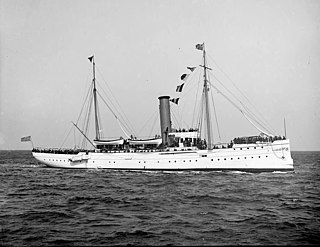 W
WUSRC Gresham was a cruising cutter and auxiliary gunboat built for the United States Revenue Cutter Service to patrol the Great Lakes. She was one of a series of cutters named for former U.S. Secretaries of the Treasury. Her namesake Walter Q. Gresham served as the 35th Secretary of the Treasury in 1884 and died in 1895 while serving as the 33rd U.S. Secretary of State. She became part of the newly created United States Coast Guard in 1915, and also served as a coastal convoy escort and patrol boat under United States Navy control during both World War I and World War II. After being decommissioned by the Coast Guard in 1944, she eventually came under Israeli control in 1947. She carried Jewish refugees from Italy to Palestine and later served in the fledgling Israeli Navy until 1951.
 W
WIntegrated Support Command Alameda is a large operating base of the United States Coast Guard, located on Coast Guard Island in Alameda, California Now known as Base Alameda
 W
WMaurice David Jester was a notable member of the United States Coast Guard. Jester enlisted in the Coast Guard as a surfman in 1917. By 1936 he had risen to the rank of Chief Boatswain. In December 1941, after the United States entered World War II, Jester was given a Lieutenant's commission, and he was given command of the USCGC Icarus (WPC-110).
 W
WThe United States Coast Guard commissioned a new Keeper class of coastal buoy tenders in the 1990s that are 175 feet in length and named after lighthouse keepers.
 W
WA lighthouse tender is a ship specifically designed to maintain, support, or tend to lighthouses or lightvessels, providing supplies, fuel, mail, and transportation.
 W
WThe Long Range Interceptor (LRI) is an 11-meter high speed launch vessel designed to be deployed from United States Coast Guard cutters via a rear launching ramp. The Long Range Interceptor is an aluminum rigid hull inflatable boat (RHIB), powered by Ultrajet brand water-jets, for intercepting and boarding suspect vessels. It mounts a radar, special shock-proof seats, and can travel at 35 knots. They can be armed with machine guns or grenade launchers, and can be equipped with ballistic panels for crew protection when required.
 W
WMachinery Technician (MK) is an enlisted rating in the United States Coast Guard that is responsible for the operation, maintenance and repair of a cutter's propulsion, auxiliary equipment and outside equipment, internal combustion engines, environmental support systems, hydraulics, generator sets, and areas of hazardous material recovery and control. They are also responsible for the engineering maintenance of any small boats assigned to their command. At smaller stations and cutters they also serve as electricians.
 W
WUSCGC Manowar (WPB-87330) is an 87-foot (27 m) long Marine Protector-class patrol boat of the United States Coast Guard built by Bollinger Shipyards in Lockport, Louisiana and was the thirtieth vessel commissioned in her class. Manowar is homeported at Galveston, Texas and her primary missions are ports, waterways and coastal security, search and rescue, law enforcement, marine environmental response, recreational boating safety and military readiness. She was commissioned in 2001.
 W
WMARSEC is the three-tiered United States Coast Guard Maritime Security system designed to easily communicate to the Coast Guard and the maritime industry pre-planned scalable responses for credible threats. Its objective is to provide an assessment of possible terrorist activity within the maritime sectors of transportation, including threats to nautical facilities and vessels falling within the jurisdiction of the United States that could be targets of attack.
 W
WMenemsha is a small fishing village located in the town of Chilmark on the island of Martha's Vineyard in Dukes County, Massachusetts, United States. It is located on the east coast of Menemsha Pond, adjacent to the opening into the Vineyard Sound on the pond's northern end. The village's historic harbor serves as the point of departure for local fishermen, some from multi-generational fishing families, as well as charter boats to the Elizabeth Islands and elsewhere. Besides charter fishing and cruises, other amenities are the public beach adjacent to the harbor and the bicycle ferry across Menemsha Pond to Aquinnah. Menemsha is the location of a United States Coast Guard station, Coast Guard Station Menemsha, and was once known as Menemsha Creek. It was the shooting background for the fictional "Amity Island" of Steven Spielberg's 1975 film Jaws.
 W
WThe Military Sea Services Museum, located at 1402 Roseland Avenue, Sebring, Florida, developed from the ideas of the members of Branch 173 of the Fleet Reserve Association (FRA). The members discussed "displaying their memorabilia to 'dress up' the building and promote the military sea services.". The museum was established in 1998, with the "Grand Opening" occurring on Memorial Day, and contains artifacts and exhibits relating to the U.S. Coast Guard, U.S. Marines and U.S. Navy, including state flags, posters, military items, and sea services memorabilia.
 W
WUSCGC Northland (WMEC-904) is a United States Coast Guard medium endurance cutter. Her keel was laid down in 1981 and she was launched in 1982 by the Tacoma Boatbuilding Company of Tacoma, Washington. She was commissioned on December 17, 1984.
 W
WUSCGC Richard Etheridge is the second of the United States Coast Guard's Sentinel-class cutters. Like most of her sister ships she replaced a 110-foot (34 m) Island-class patrol boat. Richard Etheridge was launched in August 2011.
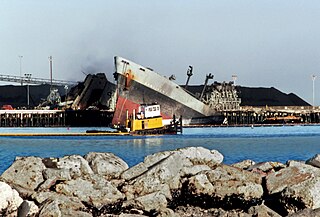 W
WSS Sansinena was a Liberian oil tanker that exploded in Los Angeles harbor on 17 December 1976. She was docked at berth 46 at Port of Los Angeles in San Pedro, California.
 W
WShore patrol are service members who are provided to aid in security for the United States Navy, United States Coast Guard, United States Marine Corps, and the British Royal Navy while on shore. They are often temporarily assigned personnel who receive limited training in law enforcement and are commonly armed with a baton. Their primary function is to make certain that Sailors, Marines, and Coast Guardsmen on liberty do not become too rowdy. They will also provide assistance for Department of the Navy and U.S. Coast Guard uniformed personnel in relations with the civilian courts and police.
 W
WThe United States Coast Guard (USCG) Short Range Prosecutor is a 7-meter, high speed launch designed to be launched from cutters, at speed, from a stern launching ramp. The Short Range Prosecutor is a rigid-hull inflatable, powered by water-jets, for intercepting and boarding suspect vessels. It mounts a radar and special shock-proof seats, and can travel at 30 knots.
 W
WThe USCGC Sockeye (WPB-87337) is the United States Coast Guard's 37th Marine Protector class cutter. She is stationed in Bodega Bay, California.
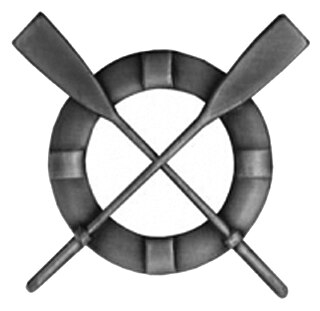 W
WSurfmen was the terminology used to describe members of the United States Lifesaving Service. It is also currently the highest qualification in the United States Coast Guard for small boat operations. Coast Guard Surfmen are rated to operate the 47-foot Motor Lifeboat in its most extreme operating conditions after undergoing training at the National Motor Lifeboat School.
 W
WUSCGC Tern (WPB-87343) is an 87-foot (27 m) long Marine Protector-class coastal patrol boat of the United States Coast Guard stationed on Yerba Buena Island in San Francisco, California. Built by Bollinger Shipyards in Lockport, Louisiana and commissioned in 2002, Tern is a multi-mission platform capable of performing search and rescue (SAR), law enforcement (LE), and fisheries patrols, as well as drug interdiction and illegal alien interdiction duties up to 200 miles off shore spanning from Mendocino County, California south to the Mexico–United States border.
 W
WThe U.S. Coast Guard Headquarters, Key West Station is a historic site in Key West, Florida. It is located at the northwest corner of the intersection of Front and Whitehead Streets. In 1973, it was added to the U.S. National Register of Historic Places.